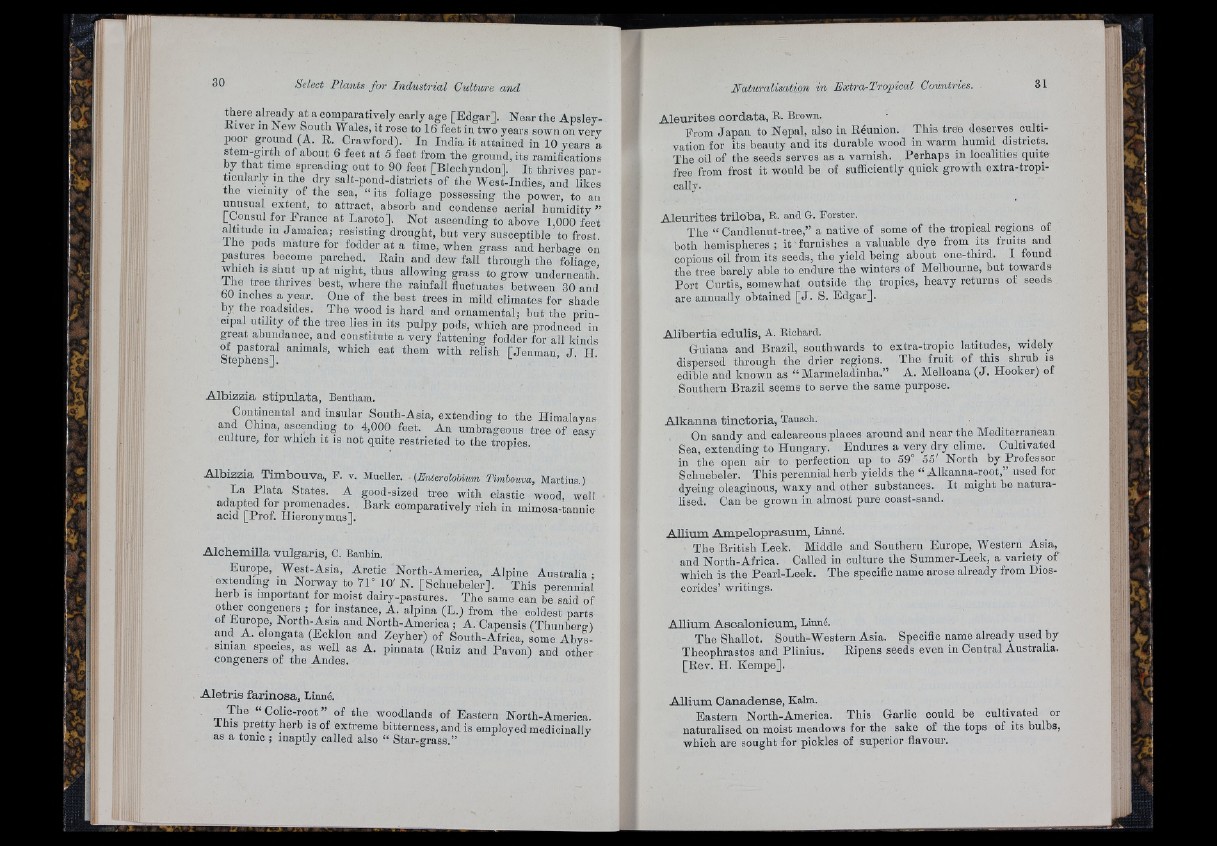
there already at a comparatively early age [E d g a r], Near the Apsley-
Kiver in New South Wales, it rose to 16 feet in two years sown on very
poor ground (A. E. Crawford). In India it attained in 10 years a
stem-g,rth of about 6 feet a t 5 feet from the ground, its ramifications
by th a t time spreading out to 90 feet [Blechyndon], I t thrives p articularly
m the dry salt-poiid-districts of the West-Indies, and likes
the vicinity of the sea, “ its foliage possessing the power, to an
unnsual e x t ^ t , to attract, absorb and condense aerial humidity ”
LConsul tor Iran o e at Laroto]. Not ascending to above 1,000 feet
altitude 111 Jamaica; resisting drought, but very susceptible to frost.
I b e pods mature for fodder a t a time, when grass aud herbage on
pastures become parched. Rain and dew fall tlirough the foHao-e
which IS shut up at night, thus allowing grass to grow underneath!
The tree thrives best, where the rainfall fluctuates between 30 and
60 inches a year. One of the best trees in mild climates for shade
by the roadsides. The wood is hard and ornamental; but the principal
utility of the tree lies in its pulpy pods, which are produced in
great abundance, and constitute a very fattening fodder for all kinds
of pastoral animals, which eat them with relish [Jeuman, J . II
Stephens]. ^ '
A lb iz z ia s tip u la ta , Bentham.
Continental and insular South-Asia, extending to the Himalayas
and China, ascending to 4,000 feet. An umbrageous tree of eL y
culture, for which it is not quite restricted to the tropics.
A lb iz z ia T im b o u v a , F. v. Mueller. (Enterolohium Timbouva, Martius.)
La P la ta States. A good-sized tree with elastic w'ood, well
adapted tor promenades. Bark comparatively rich in mimosa-tannic
acid [Prof. Hieronymus].
A lc h em illa v u lg a r is , C. Baulün.
Europe, ^ West-Asia, Arctic North-America, Alpine Australia •
extending in Norway to 71° 10' N. [Schnebeler]. This perennial
herb IS important for moist dairy-pastures. The same can be said of
other congeners ; for instance, A. alpina (L.) from the coldest parts
of Europe, North-Asia and North-America ; A. Capensis (Thunberg)
and A. elongata (Ecklon and Zeyher) of South-Africa, some Abyssinian
species, as well as A. pinnata (Ruiz and Pavon) and other
congeners of the Andes.
A le tr is fa r in o s a , Linné.
The “ Cohc-root” of the woodlands of Eastern North-America.
I his pretty herb is of extreme bitterness, and is employed medicinally
as a tonic ; inaptly called also “ Star-grass ” "
A le u rite s o o rd a ta , R. Brown.
From Jap an to Nepal, also in Reunion. This tree deserves cultivation
for its beauty and its durable wood in warm hnmid^ districts.
The oil of the seeds serves as a varnish. Perhaps in localities quite
free from frost it would be of sufficiently quick growth extra-tropi-
cally.
A le u rite s tr ilo b a , R. and G. Forster.
The “ Candlenut-tree,” a native of some of the tropical regions of
both hemispheres ; it furnishes a valuable dye from its fruits and
copious oil from its seeds, the yield being about one-third. I found
the tree barely able to endure the winters of Melbourne, but towards
Port Curtis, somewhat outside the tropics, heavy returns of seeds
are annually obtained [ J . S. Edgar].
A lib e r tia ed u lis , A. Richard.
Guiana and Brazil, southwards to extra-tropic latitudes, widely
dispersed through the drier regions. The fruit of this shrub is
edible and known as “ Marmeladinha.” A. Melloana ( J . Hooker) of
Southern Brazil seems to serve the same purpose.
A lk a n n a tin o to r ia , Tauseh,
On sandy and calcareous places around and near the Mediterranean
Sea, extending to Hungary. Endures a very dry clime. Cultivated
in the open air to perfection up to 59° 56' North by Professor
Schuebeler. This perennial herb yields the “ Alkanna-root,” used for
dyeing oleaginous, waxy and other substances. I t might be naturalised.
Can be grown in almost pure coast-sand.
A llium A m p e lo p r a sum , Linné.
The British Leek. Middle and Southern Europe, Western^ Asia,
and North-Africa. Called in culture the Summer-Leek, a variety of
which is the Pearl-Leek. The specific name arose already from Dioscorides’
writings.
A llium A so a lo n ic um , Linné.
The Shallot. South-Western Asia. Specific name already used by
Theophrastos and Plinius. Ripens seeds even in Central Australia.
[Rev. II. Kempe].
A llium C a n a d e n s e , Kalm.
Eastern North-America. This Garlic could be cultivated or
naturalised on moist meadows for the sake of the tops of its bulbs,
which are sought for pickles of superior flavour.